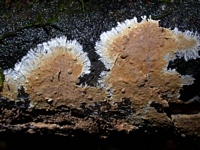|
 Asterostroma andinum Asterostroma andinum
BiostatusPresent in region - Indigenous. Non endemic
Images (click to enlarge)
Caption: Asterostroma andinum
Owner: Nils Hallenberg |
Article: Cunningham, G.H. (1963). The Thelephoraceae of Australia and New Zealand. New Zealand Department of Scientific and Industrial Research, Bulletin 145: 359 p. Wellington:.
Description: Hymenophore annual, membranous, loosely
attached, effused forming small irregular areas 1-5 x 1-3 cm; hymenial surface
ochraceous or dingy ferruginous, even, at length creviced irregularly, sometimes
pruinose; margin thinning out, fibrillose, loosely attached, concolorous,
rhizomorphs scanty but always present, white. Context fuscous, 120-200 µm thick,
basal layer dense, of parallel hyphae, varying in thickness, intermediate layer
of loosely arranged intertwined hyphae embedding masses of stellate setae;
generative hyphae 3-3.5 µm diameter, walls 0.2 µm thick, naked, with occasional
bridging hyphae. Gloeocystidia arising in the subhymenium and projecting to 20
µm, commonly fusiform, some subclavate, apices bluntly acuminate with small
acute apiculi, 40-54 x 10-22 µm. Stellate setae densely compacted, somewhat
scanty near the base, to 120 µm diameter, chestnut-brown, with 4-6 naked
aculeate rays, some bifid, to 64 µm long, walls to 2 µm thick. Hymenial layer to
70 µm deep, a scanty palisade of basidia, paraphyses, and gloeocystidia.
Asterophyses absent. Basidia cylindrical or slightly constricted in the middle,
30-36 x 7-9 µm, bearing 4 spores; sterigmata slender, to 6 µm long. Paraphyses
subclavate, 12-18 x 6-7 µm. Spores globose or subglobose, some almost pyriform,
apiculate, 6-7 µm diameter, walls smooth, hyaline, 0.2 µm thick.
Habitat: HABITAT: Effused on bark or decorticated wood of dead
branches.
Distribution: DISTRIBUTION: North and South America, Porto Rico, New Zealand.
Notes: Specific features are the globose, smooth, strongly apiculate spores,
relatively small gloeocystidia, and absence of asterophyses. Collections agree
with a specimen of A. andinum examined in Kew herbarium. They differ
from A. laxum Bres., which also has smooth globose spores, by the
larger stellate setae and gloeocystidia and absence of asterophyses. Synonyms
are given on the authority of Rogers & Jackson (1943, p. 271) who examined
types of the four species listed.
|